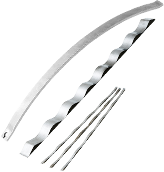Question Jack 2004/9/22(Wed) 13:32
I am designing products that use springs.
Normally, when a compression spring is mounted, hydrogen embrittlement occurs, so it is baked beforehand. However, the mass-spring manufacturer that we are working with this time said, “Because the piano wire is a drawn material and the structure is vertically elongated, there is no concern about hydrogen embrittlement, and so no baking was done.”
Following are some of the springs’ details:
・Plating: Electrogalvanized hexavalent chromium-free (5 μm or more)
・Wire: SWP-B Φ1.0
・Maximum torsional stress: 910 N/mm.
Is the baking really not necessary under the above conditions?
Answer Tokai Spring 2004/9/24(Fri) 15:50
Certainly, in the structure of oil-tempered wire which is prone to hydrogen embrittlement, has a scale-like structure, which makes it easy for hydrogen to enter, whereas the piano wire has a layered pearlite structure that extends in the vertical direction due to strong processing, which makes it difficult for hydrogen to enter.
For that reason, it is said that piano wire is less likely to cause hydrogen embrittlement. However, it is important to note that even a piano wire becomes brittle when it absorbs a large amount of hydrogen, and in extreme cases, cracks occur without external force only because hydrogen enters the structure.
Although it depends on the purpose of use, the piano wire is at a level that it is not easily affected by hydrogen embrittlement, I think that it will be worthwhile to bake it.
We are happy to answer any inquiries regarding technology, specifications, materials, etc. Please feel free to ask.

















